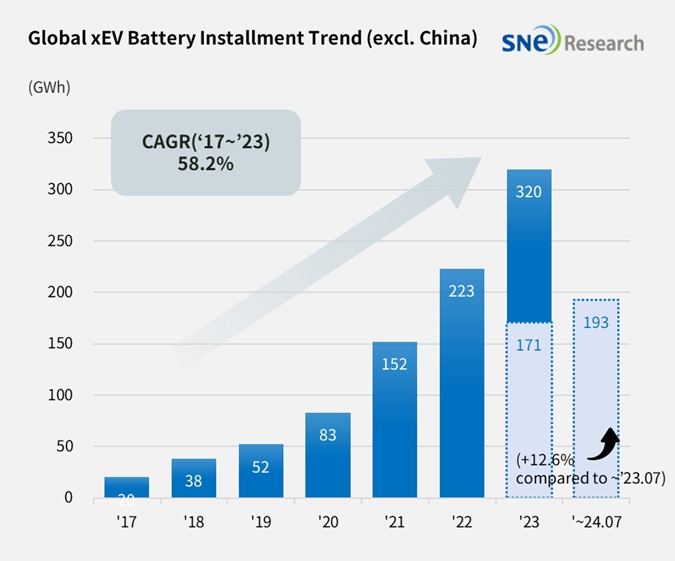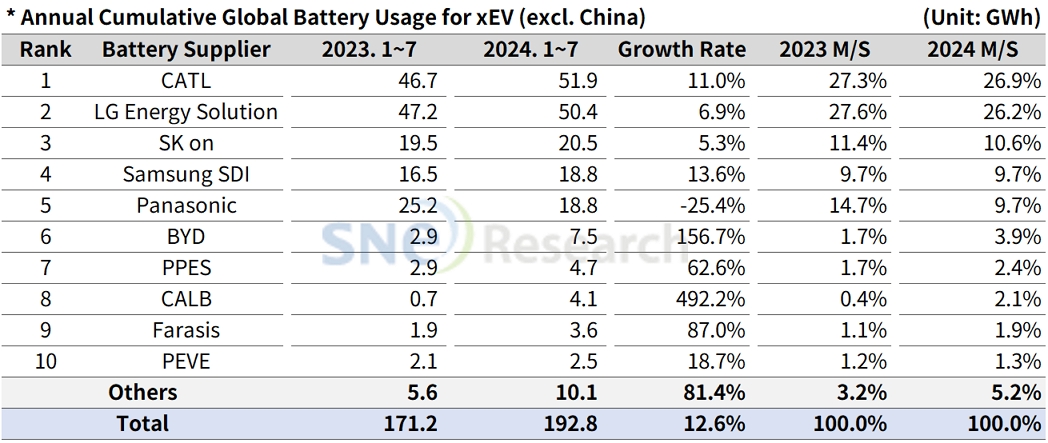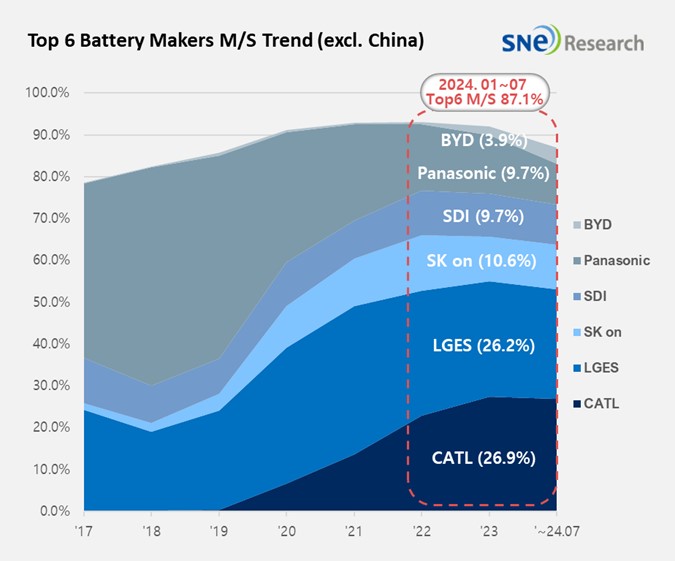From Jan to July 2024, Non-Chinese Global[1] EV Battery Usage[2] Posted 192.8GWh, a 12.6% YoY Growth
- K-trio’s combined M/S recorded 46.5% from Jan to July 2024
Battery installation for
global electric vehicles (EV, PHEV, HEV) excluding the Chinese market sold from
January to July in 2024 was approx. 192.8GWh, a 12.6% YoY growth.

(Source: Global EV and Battery Monthly Tracker – Aug 2024, SNE Research)
The combined usage of batteries made by the K-trio companies for electric vehicles from Jan to July 2024 were higher than that from the same period of last year. LG Energy Solution stayed on the 2nd place in the ranking with a 6.9%(50.4GWh) YoY growth, while SK On ranked 3rd with a 5.3%(20.5GWh) YoY growth. Samsung SDI posted the highest YoY growth of 18.8%(18.8GWh) among the K-trio companies. On the contrary, the combined market shares of K-trio were 46.5%, declined by 2.1%p compared to the same period of last year.

(Source: Global EV and Battery Monthly Tracker – Aug 2024, SNE Research)
The usage of battery made by the K-trio depends on the sales volume of models to which their battery is installed. Samsung SDI showed the highest growth among the K-trio based on solid sales of BMW i4, i5, and iX, Audi Q8 e-Tron, and Piat 500 electric in Europe as well as high sales of Rivian R1T/R1S in North America. Samsung SDI saw its operating profit drop almost 40% in the 2nd quarter of this year due to demand slowdown in the EV market. However, as it is expected that demand for xEV battery would recover in the 4th quarter, Samsung SDI forecasted that the battery industry would eventually achieve high growth in the mid to long term although it could be possible to see delays in recovery of battery demand for electric vehicles. Against this backdrop, Samsung announced that it would maintain the size of its CAPEX. Samsung SDI also has a plan to further attract new clients, expand the production of P6 battery in the States, and prepare for mass production of 46-pi cylindrical battery as well as LFP battery.
SK On, who suffered from declined sales earlier this year, saw a growth in its battery usage thanks to Hyundai Motor’s IONIQ 5, EV6, and EV9, and Ford’s F-150 Lightning of which sales were favorable recently. Both IONIQ 5 and EV6, to which the 4th generation battery by SK On is installed, have their facelift versions released in the market, which led to an expectation that their global sales would gradually expand, together with EV9. As of the 2nd quarter this year, SK On has been in red for 11 consecutive quarters since its foundation. The battery maker announced that it experienced operating losses worth of KRW 460.1 billion due to reduced operation rates in factories affected by slowdown in the EV market as well as increases in initial costs with its new factory in Hungary operating. As SK On expected that EV demand would recover in the latter half of this year with possible downward stabilization of metal price and expansion of new EV model lineups, it announced to reach the breakeven point within the second half based on demand increase and cost reduction activities.
LG Energy Solution’s growth was led by solid sales of popular models in Europe and North America such as Tesla Model 3/Y, Volkswagen ID.4, Ford Mustang Mach-E, and GM Cadillac LYRIQ. Particularly, the sales of Tesla Model 3, which momentarily slowed down while going through the facelift process, has significantly increased, leading to a sudden increase in the usage of LGES battery. Recently, KIA’s SUV EV3 and Hyundai’s Casper Electric, to which NCMA battery cells made by HLI Green Power – an Indonesia joint venture between LGES and Hyundai Motor Group – are installed, were officially launched and delivered to customers. Recently, KIA’s SUV EV3 and Hyundai’s Casper Electric, to which NCMA battery cells made by HLI Green Power – an Indonesia joint venture between LGES and Hyundai Motor Group – are installed, were officially launched and delivered to customers. Since it embarked on operation in last April, HLI Green Power is expected to become a new production base in Asia and meet the rapidly increasing need for electric vehicles in the ASEAN region. LG Energy Solution felt pressures from fixed cost when the operation rates in its European plants dropped after the demand for electric vehicles declined in the 2nd quarter of this year. However, good news was released in North America, saying that the tax credits offered under the IRA have increased more than double. Thanks to such favorable changes in the North American market, LGES announced that it managed to earn the operating profit of KRW 195.3 billion, a 24.2% QoQ. On the other hand, LG Energy Solution forecasted that, as consumer sentiment weakened after the trend of high interest rates prolonged and uncertainties in the market still lingered such as possibilities in slowing down the pace of electrification by major OEMs, the market conditions lying ahead would be touch for battery makers. In this regard, LGES foresaw that its annual sales in 2024 would decline more than 20% compared to last year. Despite such difficulties in the business environment, however, LGES placed an emphasis on that it would continue to exert its efforts to increase sales by expanding battery shipment to new models made by major OEMs in North America and Europe; meeting the need from IT product companies for their premium-line products; and expanding sales of ESS for grid.
Panasonic, the only Japanese company in the top 10 on the list, recorded 18.8GWh from Jan to July this year, ranking 5th on the list but recording a 25.4% YoY degrowth. The major reason for Panasonic’s degrowth was a slowdown in sales of Tesla Model 3 due to its transformation to the facelifted version earlier this year. As sales of Model 3 have recently expanded and Panasonic was reported to launch advanced 2170 and 4680 cells supplied to Tesla, Panasonic is expected to rapidly regain its market share mainly focusing on Tesla.
CATL, rapidly expanding its market share even in the non-China market, captured the top position with a 11.0%(51.9GWh) YoY growth. Currently, global major OEMs, such as Tesla, Mercedes, Volkswagen, and Hyundai, have adopted CATL’s battery for their electric vehicles. Although CATL saw a 13.2% YoY decline in sales of the 2nd quarter this year, recording RMB 87 billion, the net profit was RMB 12.36 billion, a 13.4% YoY increase. It was the third-highest profitability that CATL achieved since its foundation. In last April, CATL introduced high-performance LFP battery Shenxing Plus, and it is scheduled to launch its new NCM product, Qilin, in the 2nd half of this year. With both new products already decided to be installed to particular vehicles after launching, CATL is expected to further increase its share in the Chinese domestic market. In particular, CATL has decided to export its battery products to Brazil, Thailand, Israel, and Australia to deal with oversupply situations in the Chinese domestic market, making it much brighter for CATL to expand its global market share at a rapid pace.

(Source: Global EV and Battery Monthly Tracker – Aug 2024, SNE Research)
From Jan to July 2024, the global EV battery market excluding China has maintained its growth at around 10%. Despite those protectionist measures taken by the US and Europe to keep China out of the supply chain of secondary battery, China stayed in an upward trend at a steady pace as the Chinese government promotes the large-scale renewal of equipment and trade-ins of consumer goods as part of state policies to boost the domestic market. At the same time, the Chinese battery makers and EV manufacturers such as BYD, Geely, and SAIC have been continuously expanding their presence in Europe and newly-emerging countries in order to preoccupy their positions in those markets. In the short term, it is expected that the Chinese battery makers, who are currently leading the LFP battery market, would see an increase in their market shares due to the following reasons: OEMs forecasted to expand their adoption of LFP battery; increasing concern about battery safety and possible fire accidents; and risks related to the US Presidential election. Against this backdrop, in order for the K-trio to increase their market shares in future, they should be equipped with competitiveness by establishing stable supply chain and developing low- and middle-priced products with high technical quality.
[2] Based on battery installation for xEV registered during the relevant period.

